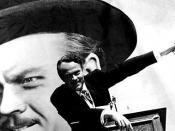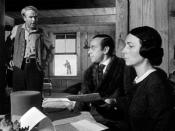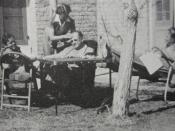"Choose a particular scene from the film and examine it closely, paying attention to both narrative content and filmic techniques."
Citizen Kane, directed, produced by and starring Orson Welles is famous for its remarkable scenes, cinematic and narrative technique, and experimental innovations. The focus of this essay is on the picnic sequence that appears late in Susan Alexander's recount to Thompson, the reporter searching for the meaning of "Rosebud". The sequence consists of around 20 shots and lasts for around 2 minutes. It signposts the end of the relationship between Susan and Kane and is essential to the film.
In the previous scene, by the enormous Xanadu fireplace, Susan is reduced to completing endless jigsaw puzzles depicting various outdoor scenes, as an escape from the cold and sterile situation that has estranged her from her husband. The couple are denied the spontaneity and ease of the outdoors after Kane's decision to have a picnic.
The sequence begins with a medium shot of a joyless and casually dressed Susan sat by Kane in the back seat of their car. Kane wears a hat and sunglasses, representing the day that we see through the rear window. The 15-second blues-style musical cue begins during the fade from Kane at Xanadu to the first shot of this scene with muted trumpets playing in the background. This music illustrates Susan's feelings and the frigid distance between herself and Kane. Whilst travelling to the picnic the couple continue to argue and, after Susan's line "You never give me anything I really care about", trombones join the trumpets, highlighting Kane's authority and the uselessness of Susan's efforts. Susan's monotone delivery and the sideways glance that she receives from Kane (through tinted glasses) also demonstrate this.
Linked by a dissolve, the next frame is a linear...


